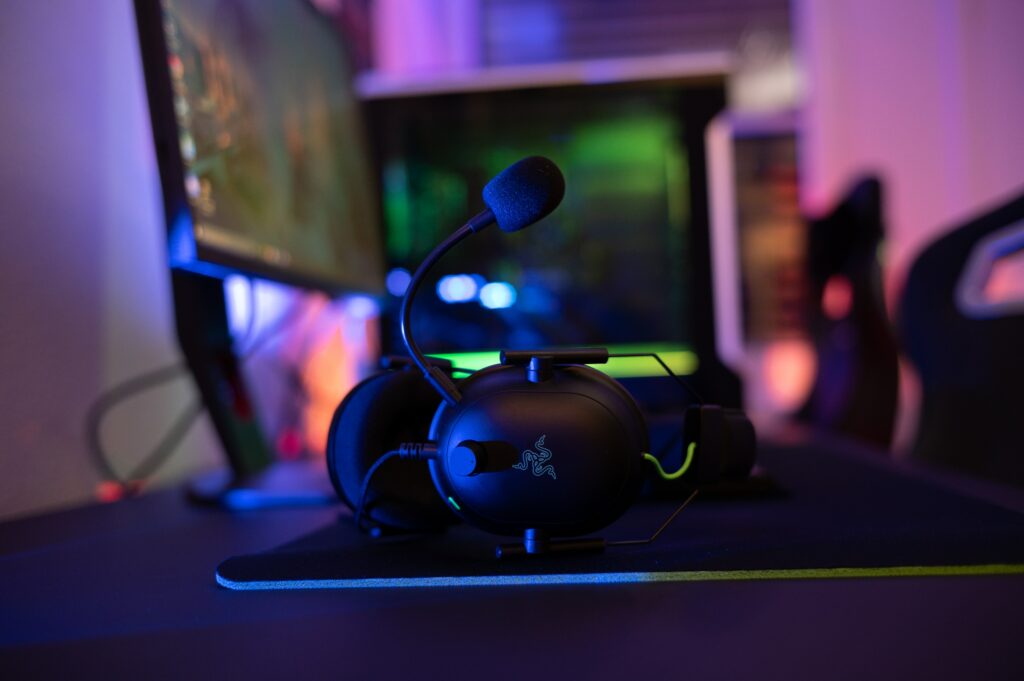The pursuit of more immersive experiences has always driven the world of gaming. From cutting-edge graphics to realistic sound design, developers have constantly sought ways to blur the line between the virtual and the real. In this quest, haptic technology has emerged as a groundbreaking innovation, and the Razer Haptic Suit is at the forefront of this revolution.
Definition of the Razer Haptic Suit and Its Significance in Gaming
The Razer Haptic Suit, also known as the Razer HyperSense Suit, is a highly-advanced, full-body gaming suit designed by Razer. Its primary goal is to provide users with touch-sensory feedback, making the virtual world feel more real and tangible. By integrating haptic technology, the Razer Haptic Suit enhances immersion by allowing gamers to feel in-game events, actions, and even emotions physically.
Mention of the Integration of Haptic Technology to Enhance Immersion
Haptic technology, also known as haptics, is the science of incorporating touch-based sensations into digital experiences. It aims to create a multi-sensory environment where users can see, hear, and feel the virtual world. With the Razer Haptic Suit, haptic technology is seamlessly integrated into gaming, bridging the gap between the physical and the virtual realms. This integration elevates the gaming experience by adding a new layer of immersion that goes beyond traditional visual and auditory cues.
Understanding the Razer Haptic Suit:
The Razer Haptic Suit, also known as the Razer HyperSense Suit, is a remarkable innovation in the realm of gaming technology. It is a full-body gaming suit developed by Razer, a leading brand in gaming peripherals. The primary aim of the suit is to provide users with unprecedented immersion by incorporating haptic technology.
The Razer Haptic Suit boasts various advanced features and capabilities that elevate the gaming experience to new heights. Designed to cover the entire body, the suit has many integrated haptic sensors strategically placed to deliver precise and dynamic touch-sensory feedback. These sensors work harmoniously to create a realistic and immersive experience by translating in-game events and actions into the user’s physical sensations.
One of the core objectives of the Razer Haptic Suit is to make the virtual world feel real. By leveraging haptic technology, the suit enables users to feel the virtual environment they are immersed in tangibly. From physical impacts like vibrations and movements to more subtle sensations that evoke emotions, the Razer Haptic Suit aims to blur the line between the digital and physical realms. The goal is to enhance the overall gaming experience by bridging the sensory gap and making the virtual world more tangible and engaging.
The suit’s advanced features and capabilities enable it to deliver various haptic effects. Users can experience everything from the subtle vibrations of footsteps or the rumble of an explosion to the haptic feedback associated with intense emotions portrayed within the game. The intricate integration of haptic technology within the Razer Haptic Suit ensures that users are visually and audibly engaged and physically connected to the virtual world they are exploring.
In summary, the Razer Haptic Suit is a full-body gaming suit that embodies the cutting-edge advancements of haptic technology. It offers a comprehensive and immersive experience by providing precise touch-sensory feedback. With its advanced features and capabilities, the suit aims to fulfill the goal of making the virtual world feel real. The Razer Haptic Suit revolutionizes gaming and elevates immersion to a whole new level by allowing users to sense in-game events and actions physically.
Razer HyperSense Technology:
Razer HyperSense is the underlying haptic technology that powers the immersive experience provided by the Razer Haptic Suit and other Razer products. It represents a significant advancement in the field of haptic feedback, bringing a new level of realism and immersion to gaming.
At its core, Razer HyperSense technology converts in-game events and actions into touch-sensory feedback that users can feel physically. The technology analyzes audio and game data in real-time and translates specific cues and events into corresponding haptic sensations. This real-time conversion ensures that users receive instantaneous and accurate feedback that complements their visual and auditory experiences.
The Razer HyperSense technology integrated within the Haptic Suit and other compatible devices is designed to deliver a wide range of sensations, adding depth and realism to the gaming experience. Users can expect to feel various haptic feedback types corresponding to different in-game events and actions.
Examples of the types of sensations that Razer HyperSense technology can deliver include:
- Impact Feedback: The technology can replicate the physical impact of actions such as gunshots, punches, or collisions. Users will feel vibrations, jolts, or gentle pulsations that mimic the force and intensity of these actions.
- Environmental Feedback: The Haptic Suit can provide haptic cues related to the virtual environment, such as walking on different surfaces like grass, sand, or metal. Users can feel distinct vibrations or textures that mimic these surfaces, enhancing the sense of presence in the game world.
- Emotional Feedback: Razer HyperSense technology can translate intense game emotional moments into haptic sensations. Users may experience vibrations, pulsations, or changes in pressure that correspond to emotions depicted in the game, adding an extra layer of immersion and emotional engagement.
- Tactile Feedback: The technology can simulate a wide range of tactile sensations, such as the feeling of textures, fabrics, or the movement of objects. Users may feel gentle vibrations, patterns, or localized pressure that mimic the physical characteristics of objects within the game environment.
Razer HyperSense technology strives to provide a comprehensive and nuanced haptic experience, amplifying the immersion factor and enabling gamers to feel the virtual world in a whole new way. By delivering accurate and dynamic touch-sensory feedback, this technology enriches the gaming experience, heightens realism, and fosters a deeper connection between players and the digital world they explore.
Immersive Gaming with the Razer Haptic Suit:
The Razer Haptic Suit is a game-changer for immersive gaming experiences. Incorporating haptic feedback elevates the sense of realism and immersion, creating a more engaging and captivating gaming environment. Let’s delve into the impact of the Haptic Suit on the gaming experience and discuss how haptic feedback enhances immersion.
Haptic feedback, provided by the Razer Haptic Suit, adds a new layer of sensory information that complements the visual and auditory aspects of gaming. It allows players to feel in-game events and actions physically, bridging the gap between the virtual and physical worlds. This integration enhances the overall realism and immersion, making the gaming experience more captivating and engaging.
One of the key benefits of haptic feedback in the Razer Haptic Suit is the ability to feel physical impacts. Whether it’s the recoil of a weapon, the rumble of an explosion, or the sensation of a collision, players can experience these events more tangibly. This heightened realism intensifies the emotional connection to the game, making it more exhilarating and immersive.
Moreover, haptic feedback in the Razer Haptic Suit allows players to feel emotions depicted within the game. By translating emotional cues into physical sensations, such as vibrations or changes in pressure, the suit enhances the emotional engagement of players. Whether it’s the adrenaline rush of a high-intensity moment or the empathy evoked by a character’s emotional state, the Haptic Suit adds a whole new dimension to experiencing and understanding emotions within the gaming world.
The benefits of feeling physical impacts and emotions in games extend beyond mere entertainment. The Razer Haptic Suit has the potential to enhance gameplay mechanics, allowing players to react more instinctively to in-game situations. The suit enables players to receive additional cues and information by providing tactile feedback, improving their situational awareness and responsiveness.
Furthermore, the Razer Haptic Suit has the potential to transform the gaming experience into a more physically engaging activity. As players feel the physical impacts and movements within the game, it encourages more active participation and physical involvement, turning gaming into a more dynamic and immersive experience.
Overall, the Razer Haptic Suit’s haptic feedback enhances immersion in gaming by providing a heightened sense of realism and tangibility. By feeling physical impacts and emotions, players are more deeply connected to the game world, fostering a more engaging and immersive experience. The benefits extend to improved gameplay mechanics and the potential for more physically active gaming. The Razer Haptic Suit opens up new possibilities for creating unforgettable and truly immersive gaming experiences.
Introduction to the Razer Kraken V3 Pro wireless gaming headset:
The Razer Kraken V3 Pro is an exceptional wireless gaming headset developed by Razer, renowned for its high-quality gaming peripherals. Designed to provide an immersive audio experience, the Kraken V3 Pro is an excellent companion to the Razer Haptic Suit, enhancing the overall gaming experience.
Description of its integration with Razer HyperSense technology:
One of the standout features of the Razer Kraken V3 Pro is its integration with Razer HyperSense technology. This integration allows the headset to work in tandem with the Razer Haptic Suit, providing users with an additional sensory dimension to their gaming experience.
Highlighting the additional sensory dimension provided by the headset:
The Razer Kraken V3 Pro adds an extra layer of immersion to gaming by delivering haptic feedback directly through the headset. As users wear the headset, they can feel vibrations, pulsations, and other touch-sensory cues that correspond to the audio signals in the game. This synchronized feedback with the Razer Haptic Suit further enhances the realism and immersion, creating a more comprehensive and captivating gaming experience.
With the Razer Kraken V3 Pro, users can experience a new level of audio immersion. They can feel the rumble of explosions, the impact of footsteps, or the subtle vibrations of environmental elements, all synchronized with the game’s audio. This additional sensory dimension adds depth and realism to the virtual world, allowing users to fully immerse themselves in the game and heighten their overall gaming experience.
Moreover, the Razer Kraken V3 Pro enhances the audio clarity and precision, enabling users to pinpoint the direction of in-game sounds more accurately. This directional audio and haptic feedback create a more immersive and realistic soundscape, enhancing gameplay and situational awareness.
The integration of the Razer Kraken V3 Pro wireless gaming headset with Razer HyperSense technology perfectly complements the Razer Haptic Suit. Together, they provide a comprehensive sensory experience, where users can feel the physical sensations through the Haptic Suit and sense the audio environment through the haptic feedback delivered by the headset. This combination amplifies immersion, elevates audio realism, and creates a truly captivating gaming experience.
In summary, the Razer Kraken V3 Pro wireless gaming headset, integrated with Razer HyperSense technology, enhances the gaming experience by providing an additional sensory dimension. Through haptic feedback delivered via the headset, users can feel audio cues and vibrations corresponding to in-game events. This synchronization with the Razer Haptic Suit further enhances immersion and realism, making the gaming experience even more captivating and engaging. The Razer Kraken V3 Pro and the Razer Haptic Suit together create a powerful duo, elevating the sensory experience of gamers to new heights.
Beta Testing and User Feedback:
Being committed to delivering top-notch products, Razer initiated a beta testing phase for the Razer Haptic Suit. During this phase, a select group of testers had the opportunity to experience the suit firsthand and provide valuable feedback. This beta testing phase aimed to gather insights and impressions from users, allowing Razer to refine and improve the Haptic Suit based on their feedback.
User feedback and impressions from testers were instrumental in shaping the development of the Razer Haptic Suit. Testers praised the suit for its ability to enhance immersion and bring a new level of realism to their gaming experiences. They emphasized how haptic feedback added a tangible and engaging dimension to their gameplay, making them feel more connected to the virtual world.
The testers reported that the suit effectively conveyed physical impacts, such as vibrations and movements, allowing them to feel the action in their games. They also highlighted the suit’s ability to translate emotional cues into haptic sensations, adding depth and intensity to their gaming experiences. Testers were impressed by the suit’s accuracy in delivering touch-sensory feedback and its synchronization with in-game events.
However, user feedback also provided insights into areas where the Haptic Suit could be improved. Some testers mentioned the need for further refinement regarding the suit’s comfort and adjustability, as wearing the suit for extended periods could become less comfortable over time. Others expressed interest in having more customization options to fine-tune the intensity and types of haptic feedback according to their preferences. These user suggestions and feedback are valuable in guiding Razer’s future iterations of the Haptic Suit.
Based on the user feedback gathered during the beta testing phase, Razer can make informed decisions to address any concerns and further optimize the Haptic Suit’s design and functionality. The feedback provides crucial insights into areas of improvement, ensuring that Razer can deliver an even more immersive and satisfying experience with future iterations of the Haptic Suit.
Razer’s commitment to user feedback and its dedication to product refinement and innovation suggest that future iterations of the Haptic Suit will incorporate improvements and enhancements based on the experiences and suggestions of beta testers. The feedback-driven iterative process will allow Razer to fine-tune the suit’s design, comfort, and functionality, ensuring that it meets the expectations and preferences of gamers seeking the ultimate immersive gaming experience.
In conclusion, the beta testing phase for the Razer Haptic Suit enabled testers to provide valuable feedback on their experiences with the suit. User feedback highlighted the suit’s ability to enhance immersion and deliver realistic touch-sensory feedback. It also highlights areas where improvements could be made, such as comfort and customization options. Razer’s attentiveness to user feedback and its commitment to product refinement indicate a promising future for the Haptic Suit, with potential improvements and iterations that will further elevate the gaming experience for users.
The Future of Haptic Technology in Gaming:
The evolution of haptic technology has already significantly impacted the gaming industry with the introduction of haptic suits like the Razer Haptic Suit. As we look toward the future, several exciting possibilities and potential advancements could further revolutionize the gaming experience.
- Enhanced Realism and Immersion: Future haptic suits will likely become even more sophisticated, providing a greater level of realism and immersion. Advancements in haptic feedback algorithms, sensor technology, and materials could result in more accurate and nuanced touch-sensory feedback. This would enable players to feel a wider range of sensations with greater precision, from subtle vibrations to intricate textures and movements.
- Haptic Suit Customization: One area that could see significant development is the customization options for haptic suits. Future iterations may offer more control and personalization, allowing users to tailor the intensity, frequency, and types of haptic feedback according to their preferences. This level of customization would enhance user comfort and ensure a personalized and immersive experience for every individual.
- Integration with Virtual Reality (VR): The synergy between haptic technology and VR is a natural progression. As VR advances, integrating haptic suits could take the virtual experience to unprecedented levels. By combining visual, auditory, and touch-sensory feedback, users can engage with virtual environments in a multi-sensory manner. This integration could deepen the sense of presence, allowing users to feel the virtual world as if it were real.
- Expansion into Other Industries: Haptic technology has the potential to extend beyond gaming and find applications in various industries. Fields such as education, healthcare, simulation training, and even entertainment could benefit from haptic feedback. For example, haptic suits could be used in medical training to simulate surgical procedures or in architectural design to provide tactile feedback on virtual models. The possibilities are vast and could enhance learning, therapy, and experiential training in different domains.
- Connectivity and Multiplayer Experiences: As haptic technology advances, the potential for enhanced connectivity and multiplayer experiences becomes more pronounced. Imagine a scenario where players can physically interact and feel the touch of other players within a virtual environment. This social and physical interaction level could bring a new dimension to multiplayer gaming, fostering collaboration, competition, and a deeper sense of shared experiences.
- Cross-Platform Compatibility: The future of haptic technology in gaming may also involve increased cross-platform compatibility. As haptic suits become more prevalent, efforts could emerge to standardize haptic feedback protocols and ensure compatibility across different gaming systems and devices. This would enable a wider range of players to benefit from haptic technology, regardless of their chosen gaming platform.
In conclusion, the future of haptic technology in gaming is promising and filled with potential advancements and innovations. As haptic suits continue to evolve, we can expect enhanced realism, increased customization options, and seamless integration with virtual reality. The impact of haptic technology extends beyond gaming, finding applications in various industries and contributing to immersive experiences in other domains. With ongoing research and development, haptic technology is poised to redefine the way we interact with virtual worlds, providing more engaging, realistic, and multi-sensory experiences for gamers and beyond.
In conclusion, the Razer Haptic Suit represents a groundbreaking leap forward in the realm of immersive gaming experiences. By integrating advanced haptic technology, this full-body gaming suit has successfully bridged the gap between the virtual and physical worlds, allowing players to feel the action and sensations within their games. Razer’s dedication to pushing the boundaries of technology is evident in their development of the Haptic Suit, which aims to make the virtual world feel real.
With the Razer Haptic Suit, gamers can now experience a new level of realism and immersion, feeling the impact of explosions, the vibrations of footsteps, and even the intensity of emotions portrayed in their games. This suit has truly revolutionized the gaming experience by introducing touch-sensory feedback, creating a more comprehensive and captivating environment.
Razer’s commitment to innovation and its proactive approach to beta testing and user feedback are commendable. By actively involving users in the development process, Razer can refine and improve the Haptic Suit to meet the expectations and preferences of gamers. The valuable insights gained from beta testers will undoubtedly contribute to the future iterations of the suit, ensuring that it continues to deliver an unparalleled immersive experience.
Looking ahead, the potential impact of haptic suits in gaming is truly exciting. As technology continues to advance, haptic suits have the potential to become even more sophisticated, providing increasingly accurate and nuanced touch-sensory feedback. Integrating haptic technology with virtual reality promises to transport gamers into truly immersive and lifelike virtual worlds, enhancing the sense of presence and interactivity.
Moreover, the influence of haptic technology extends beyond gaming. Industries such as education, healthcare, and entertainment can benefit from integrating haptic feedback, opening up new avenues for experiential learning, therapy, and simulation training. Haptic suits have the potential to redefine how we interact with virtual environments and enhance our experiences across various domains.
The Razer Haptic Suit has revolutionized the gaming landscape, introducing touch-sensory feedback and elevating immersion to new heights. Razer’s commitment to innovation and user feedback positions them at the forefront of haptic technology development. With this field’s ongoing advancements and possibilities, the future is ripe with excitement and potential for haptic suits to redefine how we engage with virtual worlds, ultimately creating more captivating and realistic gaming experiences.










